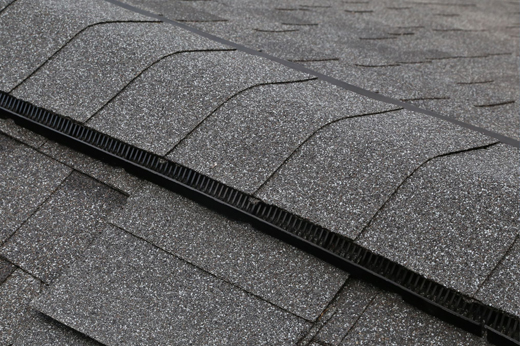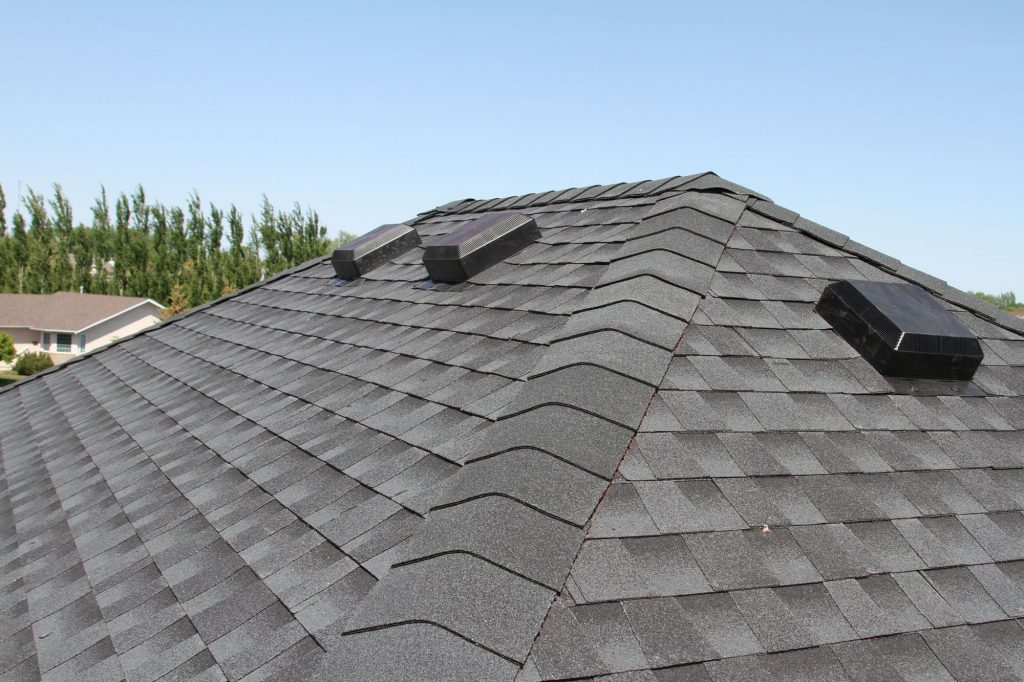A sufficient roofing ventilation system is a crucial part of a healthy home. Proper attic insulation and ventilation are important to prevent moisture build-up and early ageing or damage to your roofing materials. A poorly constructed attic or roof can result in mould, rot, ice dams, and other damage on top of an excessive energy loss.
We know roof venting can get confusing and overwhelming for the average homeowner, so we wanted to spend today’s blog explaining the importance of proper roof venting and the best ways to ensure your roof is properly vented. Want more advice and guidance with your roof’s ventilation system? Our team is always happy to help answer any questions – give us a call at 519 265-‐ROOF (7663)!

What is Roof Venting?
When you think of roof venting, you need to think of airflow. Good roof ventilation is all based around the fact that warm air rises. Since your attic is at the top of your home, proper airflow would mean cool air enters your attic near the eaves and exits near the peak with, ideally, half of the vented areas being low and the other half high. This is especially crucial in Canada as our mixed climate means your ventilation has to serve two purposes depending on the season. In the summer, on top of warm air rising into your attic, the hot sun heats your attic air. The primary purpose of your ventilation system during a hot climate is to expel this hot solar air from your attic and roof. This expelling will help reduce the burden on your air-cooling system and help decrease your home’s cooling load overall. However, in the winter, the heat from your home warms your attic air. In colder climates, your roof ventilation system needs to maintain a cold roof temperature and vent away any moisture that moves from your home into your attic. This will help prevent ice dams and moisture build-up in your attic. The ultimate goal is that the temperature and humidity levels in the attic space match the conditions outdoors.
Are There Different Types of Roofing Vents?
There are actually various types of intake and exhaust vents available for homeowners. Before our team gets to work installing roof vents, we always carefully determine how many and what type of vents a roofing system needs. Some of the things we will consider when choosing vents include homeowner preference, the unique needs of the home, architecture and roof structure, geography, and weather patterns. The most common roofing intake vents are soffit vents or drip edge vents, while common exhaust vents are ridge vents, static vents, gable vents, turbine vents, or powered vents.
- Soffit Vents are one of the most popular intake attic vent styles to have on the lower part of your roof and are generally quite hidden. These vents are great for weather, debris, and pest protection while still providing airflow for your attic. Common materials include aluminum or vinyl and they look like perforated holes in your home’s soffit.
- Edge Vents are another intake venting option that allows for proper attic ventilation while also encouraging water shedding and rakes at the roof. They are made of a corrosive‐resistant material that sits inside your roof deck just above the eavestrough. These are installed in areas with tough to vent soffits.
- Ridge Vents are a type of exhaust vent that is laid along the ridge of a roof in separate or one lone piece. They provide a nice open area for your attic to expel warm air across the entire length of the attic.
- Static Vents come in many different sizes and styles installed near the roof ridge to create unobstructed airflow from the attic. If a home has multiple static vents, they should be placed as evenly spread out as possible. Metal is the best option here as rodents do not like to chew metal therefore deterring them from entering attic spaces.
- Maximum Vents or wind turbine vents (whirlybirds) stand higher than traditional vents and provide increased ventilation in areas that could be tough to vent. When the wind blows across these vents, it creates a vacuum effect, and the air is pulled through them from inside the attic. They provide a much higher rate of ventilation and are in addition to standard venting.
- Gable Vents are slotted pieces of siding or wood installed into the side of the home near the gable peak. Although they rely on wind to be effective, gable vents can operate as both intake and exhaust vents.
- Powered Vents are essentially exhaust fans for your roof that can be controlled by a thermostat or moisture monitor. The vent’s blades will “turn on” and spin under a powered motor to release attic air until the correct temperature or moisture levels are reached.
- Solar vents are a great option. They utilized the power of the sun and will turn on and pull air from the attic. Even on very cloud-covered days, they will continue to operate and spin if there is light.

Does My Attic Need More Ventilation?
There are some telling signs that you need to improve your venting system. The first and most obvious sign is to simply look for roof vents yourself. Look for attic vents on the roof or in the eaves of your home. There are many different types of vents that may be included in your home, like the ones mentioned above, so remember to look for the lower profile ones as well as the more commonly known vent types.
Another way to test your ventilation system is to touch your ceiling on a hot day to see if it is hot to the touch. This would indicate that your attic is not venting hot air and instead, acting like a solar oven and trapping heat. This would also be a potential sign of low insulation levels. Another sign of poor attic ventilation is a clean (or patchy areas), snow-free roof deck in the winter when all your neighbours’ roof decks are covered in snow or ice. This, along with thick ridges of ice on your roof, means your attic is not expelling warm air and is warm enough to melt away the snow. This means heat is escaping! During the winter, you can also grab a flashlight and take a peek at your attic from the inside to inspect for any dampness or frost. Of course, the easiest and safest way to see if you need to improve your venting system is to leave it to the professionals. Empire Roofing & Exteriors can calculate the amount of ventilation your home needs to create a balance of intake and exhaust. There are many different types of vents we can install that will fit the unique needs of your roof and home.
Empire Roofing and Exteriors is your best choice for Roofing Repairs in Guelph, Cambridge & surrounding areas.
As a professional Guelph Roof Repair company, Empire Roofing & Exteriors will be there for you now and in the future. You can trust our local, reputable, and licensed roof repair services backed with years of proven experience. All your roof repairs will be handled by our licensed and insured workers, all of which are carefully vetted and selected because of their commitment to quality and safety.
Let the roofing experts at Empire Roofing & Exteriors get your roof done the right way today by calling 519 265-‐ROOF (7663) or fill out our online quote form.
Don’t forget to ask us about our financing options as well through FinanceIt, the most powerful financing in the industry.
